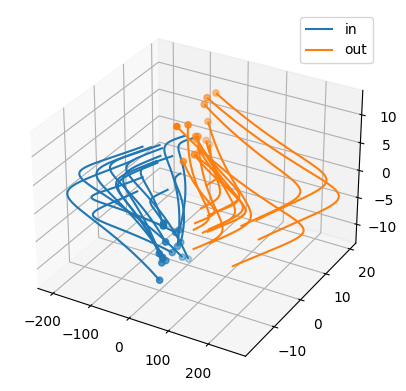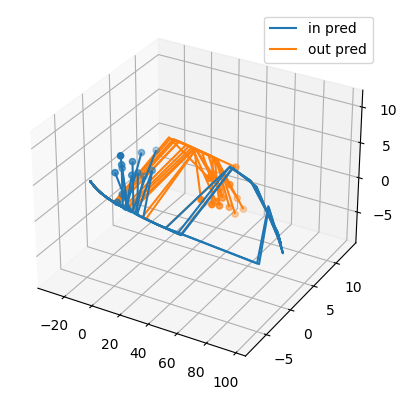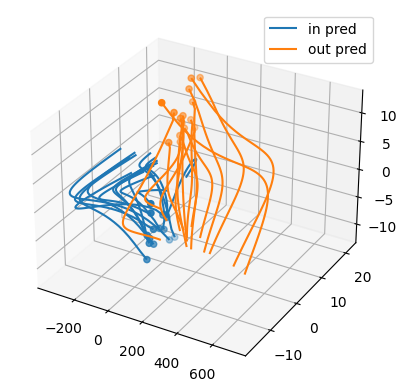DynaDojo is a Python API for testing how models generalize and efficiently use samples in dynamical system identification. Our platform lets you understand how a model performs as various parameters are adjusted, including tuning the complexity of the system (e.g., dimension), increasing the dataset size, changing the number of timesteps per trajectory, control, adding noise, adjusting the distribution of initial conditions, and more.
You can install DynaDojo with pip:
pip install dynadojoThere are three ways to interact with DynaDojo and users can take on multiple "hats" at a time. You can add new dynamical Systems to the platform, create set environments for adjusting parameters in a Challenge, or implement your Model with our API to understand how it performs. Most of the platform is adjustable through various parameters in these clases.
DynaDojo comes with three off-the-shelf challenges: Fixed Error, Fixed Complexity, and Fixed Train Size.
from dynadojo.systems import LDSSystem
from dynadojo.baselines import LinearRegression, DNN
from dynadojo.challenges import FixedComplexity
import pandas as pd
challenge = FixedComplexity(
N=[10, 100, 1000], # number of training examples
l=3, # latent dimension
e=3, # embed dimension
t=50, # timesteps
control_horizons=0,
max_control_cost_per_dim=0,
system_cls=LDSSystem,
trials=10,
test_examples=50,
test_timesteps=50,
)
data1 = challenge.evaluate(LinearRegression, id="linear regression")
data2 = challenge.evaluate(DNN, algo_kwargs={"activation": "relu"}, fit_kwargs={"epochs": 20}, id="nonlinear network")
data3 = challenge.evaluate(DNN, fit_kwargs={"epochs": 20}, id="linear network")
data = pd.concat((data1, data2, data3))
challenge.plot(data)Out (Fixed Complexity, C = latent_dim = 5): Note how for this LDSSystem, a linear network learns more from each added sample (larger decreases in error) than a nonlinear network, and how linear regression immediately saturates at very low error. These dynamics help contextualize model performance and comparision.
DynaDojo comes with 20 pre-built systems (including ODEs and PDEs) that range from mature mathematic simulations, to bounded confidence opinion dynamics, biology, ecology, and epidemology:
- Cellular Automata
- Threshold Linear Networks
- N-Body Systems
- Linear Dynamical Systems (LDS)
- Generalized Lorenz
- Spiking Neural Network (SNN)
- Kuramoto N-Oscillators
- Generalized Prey-Predator
- Competitive Lotka Volterra
- Deffuant
- Algorithmic Bias with Media Influence
- Hegselmann-Krause (HK)
- Weighted Hegselmann-Krause (WHK)
- Attraction-Repulsion Weighted Hegselmann-Krause (ARWHK)
- SIR: Susceptible/Infected/Removed
- SIS: Susceptible/Infected/Susceptible
- SEIS: Susceptible/Exposed/Infected/Susceptible
- 2D Heat Equation
- Black-Scholes-Barenblatt (BSB)
- Hamilton-Jacobi-Bellman (HJB)
To add new systems to DynaDojo, you subclass from AbstractSystem and implement the required functions listed below. It is easy to build a System from scratch, or to use existing packages like scipy and NDLIB and wrap them for our API.
import numpy as np
from dynadojo.abstractions import AbstractSystem
class MySystem(AbstractSystem):
def make_init_conds(self, n: int, in_dist=True) -> np.ndarray:
pass
def make_data(self, init_conds: np.ndarray, control: np.ndarray, timesteps: int, noisy=False) -> np.ndarray:
pass
def calc_error(self, x, y) -> float:
pass
def calc_control_cost(self, control: np.ndarray) -> np.ndarray:
pass
def __init__(self, latent_dim, embed_dim):
super().__init__(latent_dim, embed_dim)Documentation for each of the abstract methods can be found in dynadojo/abstractions. Use tester.py to verify that your new system accurately integrates with DynaDojo.
DynaDojo comes with six baseline models:
- CNN
- DMD (Schmid, Peter J., "Dynamic mode decomposition of numerical and experimental data")
- DNN
- Lowest Possible Radius (LPR)
- Linear Regression (LR)
- SINDy (Brunton, Steven L., Joshua L. Proctor, and J. Nathan Kutz., "Discovering governing equations from data by sparse identification of nonlinear dynamical systems")
Adding new models is simple with DynaDojo. The developer simply needs to implement two abstract methods fit and predict. A model can also optionally use control with the act method.
import numpy as np
from dynadojo.abstractions import AbstractAlgorithm
class MyModel(AbstractAlgorithm):
def __init__(self, embed_dim: int, timesteps: int, max_control_cost: float, **kwargs):
super().__init__(embed_dim, timesteps, max_control_cost, **kwargs)
def fit(self, x: np.ndarray, **kwargs) -> None:
pass
def predict(self, x0: np.ndarray, timesteps: int, **kwargs) -> np.ndarray:
pass
#optional, used when control desired
def act(self, x: np.ndarray, **kwargs) -> np.ndarray:
passNonlinearity is a hallmark of modern deep learning; however, there are some exceptional tasks where linear models actually outperform nonlinear neural networks. In this example, we explore this phenomena through linear dynamical systems (LDS) and deep neural networks (DNNs).
To start, let's create some LDS data using one of DynaDojo's off-the-shelf LDSSystem.
import dynadojo as dd
import numpy as np
latent_dim = 5
embed_dim = 10
n = 5000
timesteps = 50
system = dd.systems.LDSSystem(latent_dim, embed_dim)
x0 = system.make_init_conds(n)
y0 = system.make_init_conds(30, in_dist=False)
x = system.make_data(x0, control=np.zeros((n, timesteps, embed_dim)), timesteps=timesteps)
y = system.make_data(y0, control=np.zeros((n, timesteps, embed_dim)), timesteps=timesteps)
dd.utils.lds.plot([x, y], target_dim=min(latent_dim, 3), labels=["in", "out"], max_lines=15)In the image below, observe how the in distribution trajectories (blue) have a different evolution than the out-of-distribution trajectories (orange). A robust model should be able to predict the orange trajectories even if it's only trained on the blue ones.
Next, let's create our nonlinear model using DynaDojo's baseline DNN class.
nonlinear_model = dd.baselines.DNN(embed_dim, timesteps, activation="tanh", max_control_cost=0)
nonlinear_model.fit(x)
x_pred = nonlinear_model.predict(x[:, 0], 50)
y_pred = nonlinear_model.predict(y[:, 0], 50)
dd.utils.lds.plot([x_pred, y_pred], target_dim=min(3, latent_dim), labels=["in pred", "out pred"], max_lines=15)
x_err = system.calc_error(x, x_pred)
y_err = system.calc_error(y, y_pred)
print(f"{x_err=}")
print(f"{y_err=}")Out:
x_err=203.1404201824185
y_err=346.67112531011145
As we can see, the model performs pretty badly. With 10 epochs of training, it struggles to predict both the in and out-of-distribution trajectories!
Next, let's try DNN with a linear activation.
linear_model = dd.baselines.DNN(embed_dim, timesteps, activation=None, max_control_cost=0)
linear_model.fit(x)
x_pred = linear_model.predict(x[:, 0], 50)
y_pred = linear_model.predict(y[:, 0], 50)
dd.utils.lds.plot([x_pred, y_pred], target_dim=min(3, latent_dim), labels=["in pred", "out pred"], max_lines=15)
x_err = system.calc_error(x, x_pred)
y_err = system.calc_error(y, y_pred)
print(f"{x_err=}")
print(f"{y_err=}")Out:
x_err=21.46598299085367
y_err=243.8198349312669
As we can see, the linear model does much better! This is because linear models learn linear dynamics faster.
This software is made available under the terms of the MIT license. See LICENSE for details.
The external dependencies used by this software are available under a variety of different licenses. Review these external licenses before using the software.








